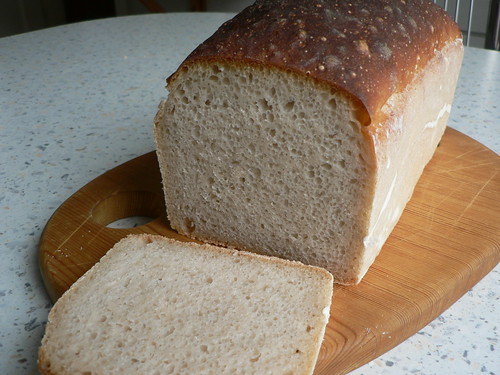Moro Sourdough Bread
| -========= | REZKONV-Recipe – RezkonvSuite v1.4  |
| Title: | Moro Sourdough Bread |
| Categories: | Bread, Leaven |
| Yield: | 2 Loaves |
Ingredients
| H | STAGE 1: FRIDAY NIGHT BEFORE YOU GO TO BED | ||
| 450 | grams | Unbleached strong white bread flour, preferably | |
| — organic | |||
| 700 | ml | Cold water | |
| 250 | grams | Sourdough Starter (167 % Hydration) | |
| H | FEEDING THE ORIGINAL SOURDOUGH STARTER | ||
| 150 | grams | Unbleached strong white bread flour, preferably | |
| — organic) | |||
| 250 | ml | Cold water | |
| H | STAGE 2: SATURDAY UP TO MIDDAY | ||
| 450 | grams | Unbleached strong white bread flour, preferably | |
| — organic | |||
| 2-3 | teasp. | Fine sea salt, depending on how sour the dough is | |
| Olive oil or sunflower oil for oiling bread tins | |||
| Extra flour, bread or fine semolina for dusting | |||
Source
 * * |
The Moro Cookbook * |
| Edited *RK* 06/15/2007 by | |
| Ulrike Westphal |
Directions
STAGE 1: FRIDAY NIGHT, BEFORE YOU GO TO BED
In a mixer, with a dough hook, or by hand in a large bowl, mix the flour, water and starter together until more or less smooth. Transfer to a larger bowl if the mixture comes above two-thirds, for it will rise a little bit. Cover and leave overnight.
Now feed the original sourdough starter:
Add the flour and water to the original starter and mix with your hands until incorporated. It does not matter if there are a few lumps as these will disappear. Put back in the fridge.
STAGE 2: SATURDAY UP TO MIDDAY
You will need two 450 g rectangular bread tins, roughly 22 cm long by 11 cm wide and 6.5 cm high. Add the flour and salt to the existing bowl of dough that has been resting overnight and mix with your hand until smooth or turn the machine on to a low setting. When mixed in, beat by hand (with the tips of your fingers) for a good 5-10 minutes or continue in the machine for 5 minutes until more or less smooth and elastic. This dough does not need to be kneaded on a floured board, as it is too wet anyway. Rest for another 5–10 minutes to relax the dough. Beat again for a couple more minutes. Check for salt. A sourdough will need slightly more salt than bread made with commercial brewer’s yeast because of its sour flavour. We always taste a little bit of the dough to make sure the balance is right.
Now prepare the bread tins. Oil them well, then dust the inside generously with flour (bread or semolina). Divide the dough and fill each tin just over half, but no more than two-thirds, full, Dust the top with more flour. Depending on the room temperature and activity of the starter, the dough will need 3-5 hours to prove until increased in size by a third at least, or the dough has risen just over the top of the tin. To see if it is ready, press your hand gently on top of the dough. It should feel light and airy.
STAGE 3: SATURDAY AFTERNOON
When the dough is roughly in its last hour of rising, preheat the oven to 230 °C/450 °F/Gas 8. When the oven is up to temperature and you are satisfied the dough has risen sufficiently, place the tin on the middle shelf. Bake for a good 30 minutes (try not to give in to the temptation to look at it for the first 15 minutes as it can affect the rise). When the 30 minutes are up, remove the bread from the tins and bake for a further I0-15 minutes. If the bread has formed a good hard crust and has browned it is ready. To make extra sure, tap the bottom, which should feel hollow. Transfer to a cooling rack and leave until completely cool. It is always tempting to cut the bread before it has totally cooled, but if you do, the steam will be released and change the texture. Bread with a perfect texture should have even holes and a glossy look to it. If your bread is split or cracked in any way, then it means it had not quite proved enough.
=====
*=Affiliate-Link zu Amazon


